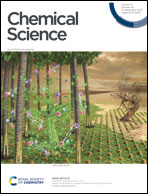Design of a robust and strong-acid MOF platform for selective ammonium recovery and proton conductivity†
Abstract
Metal–organic frameworks (MOFs) are potential candidates for the platform of the solid acid; however, no MOF has been reported that has both aqueous ammonium stability and a strong acid site. This manuscript reports a highly stable MOF with a cation exchange site synthesized by the reaction between zirconium and mellitic acid under a high concentration of ammonium cations (NH4+). Single-crystal XRD analysis of the MOF revealed the presence of four free carboxyl groups of the mellitic acid ligand, and the high first association constant (pKa1) of one of the carboxyl groups acts as a monovalent ion-exchanging site. NH4+ in the MOF can be reversibly exchanged with proton (H+), sodium (Na+), and potassium (K+) cations in an aqueous solution. Moreover, the uniform nanospace of the MOF provides the acid site for selective NH4+ recovery from the aqueous mixture of NH4+ and Na+, which could solve the global nitrogen cycle problem. The solid acid nature of the MOF also results in the proton conductivity reaching 1.34 × 10−3 S cm−1 at 55 °C by ion exchange from NH4+ to H+.



 Please wait while we load your content...
Please wait while we load your content...